Day 1
We took a Flixbus overnight from Eindhoven to Munich, a trip that took more than 10 hours. Besides being cheap, there aren’t many perks to this kind of journey—sleeping upright in a seat and not being able to stretch your legs is tough, and then having to start exploring right after arriving is even tougher. But, at least we saved two nights’ worth of accommodation costs, which is great because otherwise, I’d be broke.
For this trip, we found some travel buddies from an exchange student community, so we ended up doing a road trip. This way, we didn’t have to spend too much time on public transportation, especially since the places we planned to visit, like Lake Königssee and Neuschwanstein Castle, are pretty far from the city center.

When you see this gate, you know you’ve arrived at Munich’s old town. There are many shops and restaurants inside, perfect for a leisurely stroll.
Residenz Munchen

Our first stop was the Munich Residence, and this was probably my first time visiting such a lavish palace! As I walked through, I kept imagining what it would be like to live in a huge castle if I were super rich—it would be awesome!
There is an entrance fee, but it’s not too expensive, and they offer an audio guide in Chinese, which is really helpful. Otherwise, there’s a lot of history and strange jargon, and I’d probably have given up on understanding it in English. Honestly though, I nearly gave up even with the Chinese guide because I know so little about history! One of the things that stood out was how much of the palace was destroyed during WWII, which is unfortunate. Many of the rooms have been reconstructed, so they don’t look as extravagant as I had imagined.
One room that really impressed me featured a trick of perspective—a fresco that makes the ceiling look much higher than it really is, depending on where you stand.

Look at all that gold! I’m so envious.
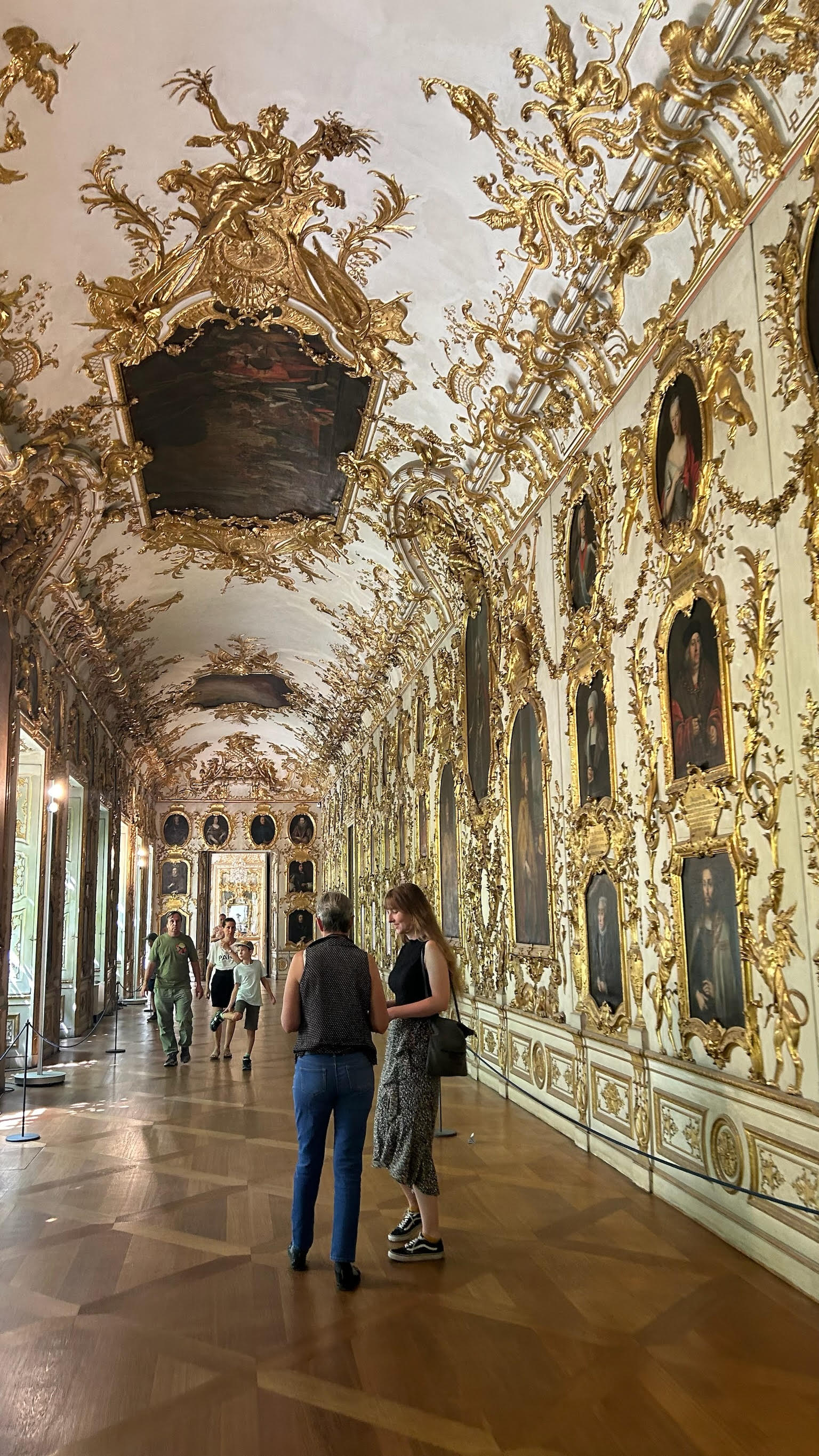
Each of these portraits is a family member of the royal house that lived here.

They even have a family tree! So cool.
Dachau Concentration Camp Memorial Site
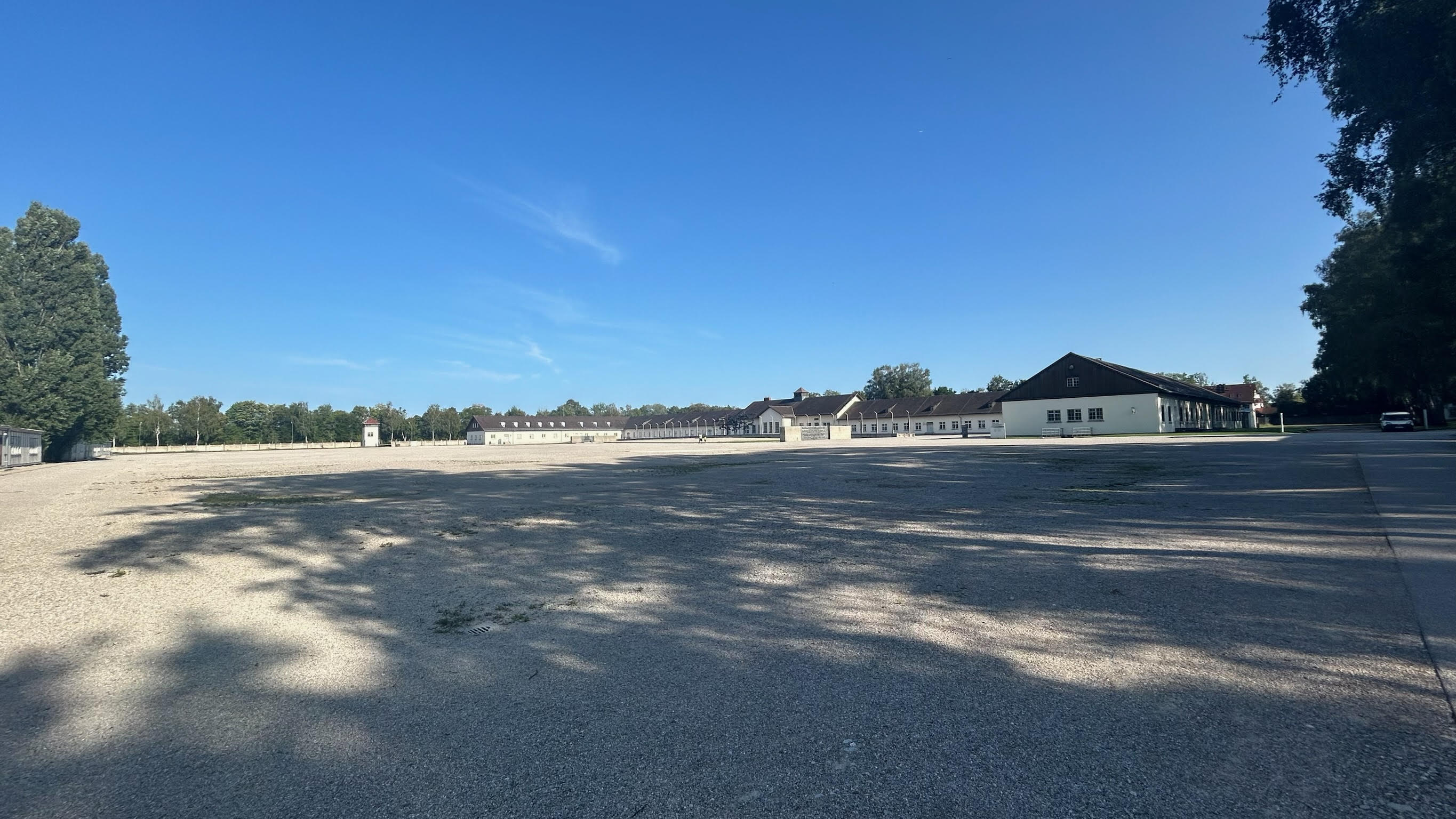
Highly recommended! Dachau is huge, but it’s not so much about being a fun place to visit. Rather, it’s where you can learn more about the atrocities committed by the Nazis, and some details you might not have known even if you’ve seen films about the Holocaust.
A unique feature of this camp is that there aren’t many exhibits left—most were destroyed. Only one restroom and one dormitory remain, but the written descriptions are incredibly detailed, almost like reading a long English novel. In the main exhibit area, there are numerous large panels filled with text, in both German and English. I didn’t rent an audio guide due to time constraints, but the written information alone was overwhelming and deeply disturbing. Even now, thinking about it gives me chills.
There are scheduled documentary screenings at certain times, but unfortunately, I arrived too late and missed it.
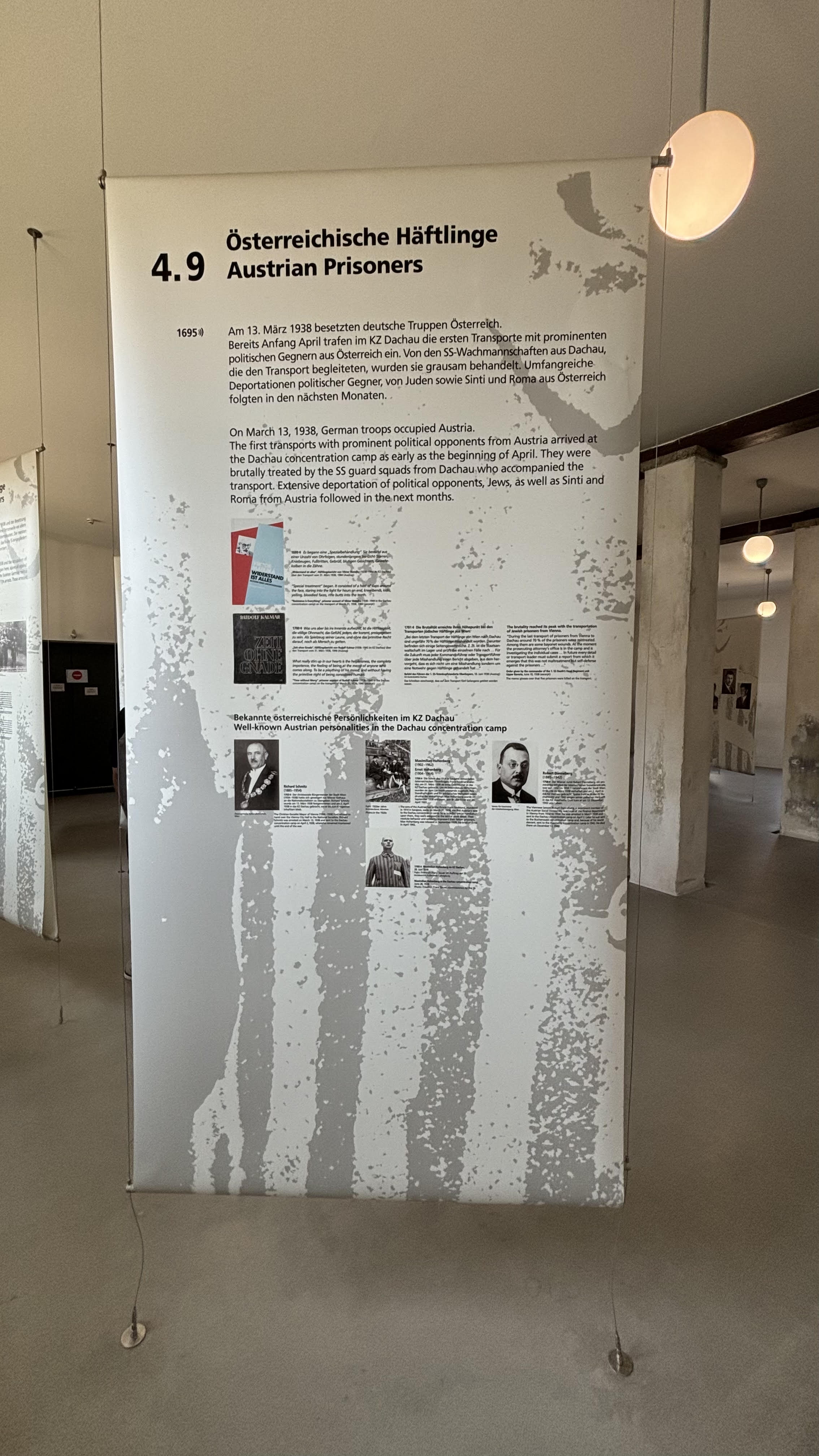
Here are some of the panels with rich explanations, though some images were too graphic, so I won’t include them all. Just documenting the experience.

This image shows the daily roll call, where prisoners were forced to stand outside for hours regardless of weather—rain, wind, or freezing cold—without sufficient clothing.

This is one of the dormitory beds. It looks like several people had to share one bed, and there were hardly any blankets. The camp was severely overcrowded.
Dachau Concentration Camp Memorial Site Location
Marienplatz & Neues Rathaus

This is Munich’s heart, with its iconic Gothic architecture. To be honest, I can only throw out a few buzzwords here—Gothic style, historic landmark—but mainly, we came here to climb a nearby church tower and snap a few pictures. The square was bustling with people, and it was a surprise to see how lively Munich stays even late at night. I had always imagined that Europe didn’t have much of a nightlife, but there were people out drinking until 10 or 11 p.m.!
St. Peter

St. Peter’s offers the best panoramic views of Munich. We climbed up, embracing the “new city, new viewpoint” motto. The climb was relatively easy, with a gentle slope, and the tower wasn’t as high as others I’ve been to, so it didn’t feel too overwhelming.
The pictures of Marienplatz and the cover photo of this post were taken from St. Peter’s. Every time I climb a tower like this, I notice there’s usually one or two angles that are particularly stunning. Here, the best view was definitely the one with the orange rooftops, giving the city a clean and elegant feel. I love the color scheme, and the Gothic architecture of Marienplatz adds a classical charm.
Cuisine
Weisses Bräuhaus im Tal

A must-visit for an authentic Munich breakfast! This place is famous for its Weißwurst (white sausage), made from a mix of pork and veal, which is boiled and served with the water. Apparently, locals don’t eat the casing. They bite a hole in it and suck out the meat, which I found quite unique. I gave it a try, and it’s true—the casing is tough, but the sausage itself is delicious.
However, note that the listed price is 3.5 EUR per sausage, but there’s a minimum order of two per person, so the actual price is 7 EUR. They also serve pretzels, which are famous here, and they pair really well with the sausage—crispy on the outside and sprinkled with salt. Just don’t grab the pretzels without checking first; they aren’t free!
Weisses Bräuhaus im Tal Location
Vinzenzmurr Metzgerei - München - Maxvorstadt

This was our lunch spot—a local, budget-friendly recommendation from our travel buddies. I remember the crispy pork belly sandwich and stewed beef with mashed potatoes cost only 17 EUR together. That’s quite affordable compared to the Netherlands. I didn’t know what these dishes were called in German, so I used Google Translate to show them my request for “crispy pork belly sandwich and stewed beef with mashed potatoes.” Surprisingly, they understood!
At first glance, it looks like just a sandwich with pork, but the secret is in the bread. German bread has this amazing aroma and a chewy texture that’s hard to describe—it’s nothing like the soft bread you find elsewhere. The crispy pork inside makes it super satisfying.
Vinzenzmurr Metzgerei - München - Maxvorstadt Location
Day 2
Today, our main destination was Königssee. It took about two hours to drive from Munich, and by the time we returned, it was quite late. I think one or two days is enough for this area, at most you could add a hiking trip. Some people stay here for three or four days, but that seems like a bit too long for me, haha.
Königssee
Königssee is incredibly beautiful, like something out of a traditional Chinese landscape painting. We were really lucky to have great weather with lots of sunshine, so every photo we took turned out amazing. There are three main spots to visit here: the starting point (Königssee), St. Bartholomä Church, and Obersee. We took the boat from the starting point to St. Bartholomä, then from there to Obersee, and finally back to the start.
The cell signal around Königssee isn’t great, but as long as you know which boat you’re taking and where you’re going, it’s pretty straightforward. The rest is just non-stop photo taking.

A ticket for the full route, which includes stops at St. Bartholomä and Obersee, costs 28 EUR. The ticket shows the pier and time, so you just wait there and get on board.
Starting Point

On the way from the parking lot to Königssee, we passed a lot of small stands and shops. It felt pretty rare to see so many street vendors selling snacks and souvenirs in Europe.
Even before getting on the boat, the lake’s clear, emerald-green water was stunning. It looked like something out of a fantasy, almost too perfect. But for some reason, there were so many bees here! We sat by the lake, chilling and having lunch in the sun, and the bees just kept landing on our food. I didn’t dare to shoo them away, though the locals said it’s totally normal.
Scenery from the Boat

Make sure to queue up early to get a window seat on the boat. The scenery is breathtaking, and what I enjoyed most was the feeling of being surrounded by the green lake and the steep cliffs on either side. It’s like something you’d only see on TV. It didn’t feel like we were just traveling to the next spot; it felt more like a lake cruise, where you could soak in all the views.
The boat guide was pretty funny. He used a loudspeaker to play a trumpet toward the cliffs, saying we’d hear an echo seven times, though I didn’t count. This was the only part I understood, as the whole tour was in German, which I couldn’t follow at all.
St. Bartholomä

This place is named after the iconic red onion-domed church. I’ve seen plenty of churches, so I just took a quick peek inside, and to my surprise, they had air conditioning! I can’t even remember how long it’s been since I’ve felt AC in Europe.
I didn’t know beforehand, but if the weather’s good, you can wade in the water here. A lot of people go swimming, and because it was a hot day, the cool lake water was really refreshing. The shoreline is pebbled, so it’s easy to clean up afterward. While on the boat, we even saw someone swimming out toward the middle of the lake—it almost looked like they were going to swim up to the boat!

By the way, here’s a dreamy shot of the valley.
Obersee

After getting off the boat, you have to walk about 20 minutes to reach Obersee, so make sure to plan time for the round trip to avoid missing the last boat.
Most people say Obersee is more beautiful, but after seeing it myself, I still think the scenery around St. Bartholomä is more impressive because the lake here is smaller. It could’ve been the lack of sunlight when we visited, or maybe I just prefer grand, expansive landscapes.

To see the inner lake, you’ll need to walk along this path, but it’s not a long or difficult walk.
Zauberwald

Many people combine Zauberwald with a visit to Königssee as a day trip since they’re not far from each other by car. However, we spent so much time at Königssee that we arrived at the Magic Forest quite late. I think it would be a lovely spot on a sunny day. There seemed to be a lot of areas to walk around and explore, but we didn’t have time. We just took a few photos nearby.
We also sneaked onto someone’s boat for a quick photo op. The boats were already locked up for the night, and there were people rowing in the lake who kept glancing at us—we were so nervous! Maybe it was their boat, haha.
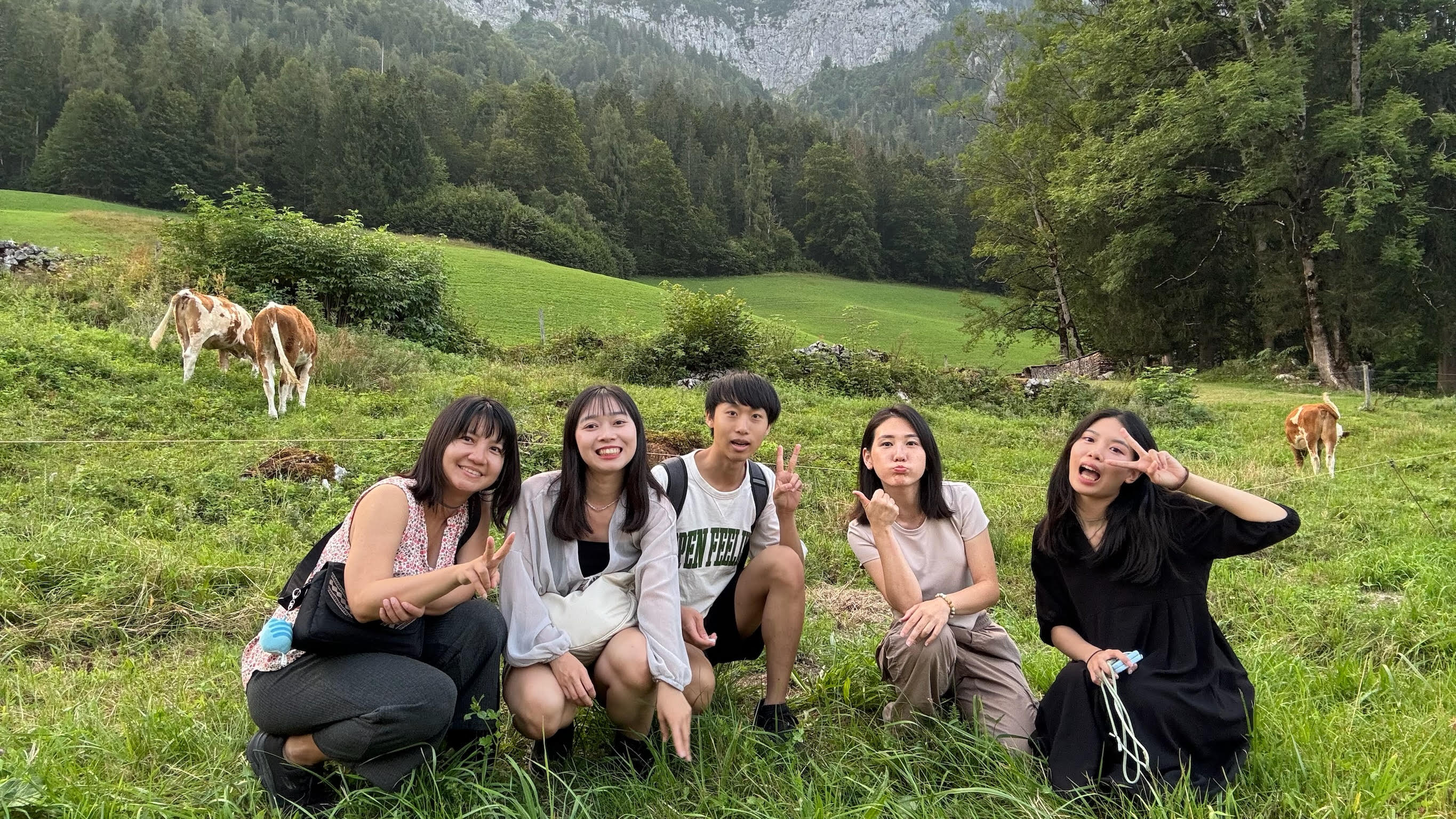
Also, for some reason, there were cows nearby—super cute!
Day 3
Day three was all about visiting Schloss Neuschwanstein. It was another hour and a half to two-hour drive from the city. The weather in Europe really changes quickly. The day before was sunny, but today it rained heavily, and it got super cold! We were caught off guard. You really need to pack both summer and winter clothes here.
Schloss Neuschwanstein
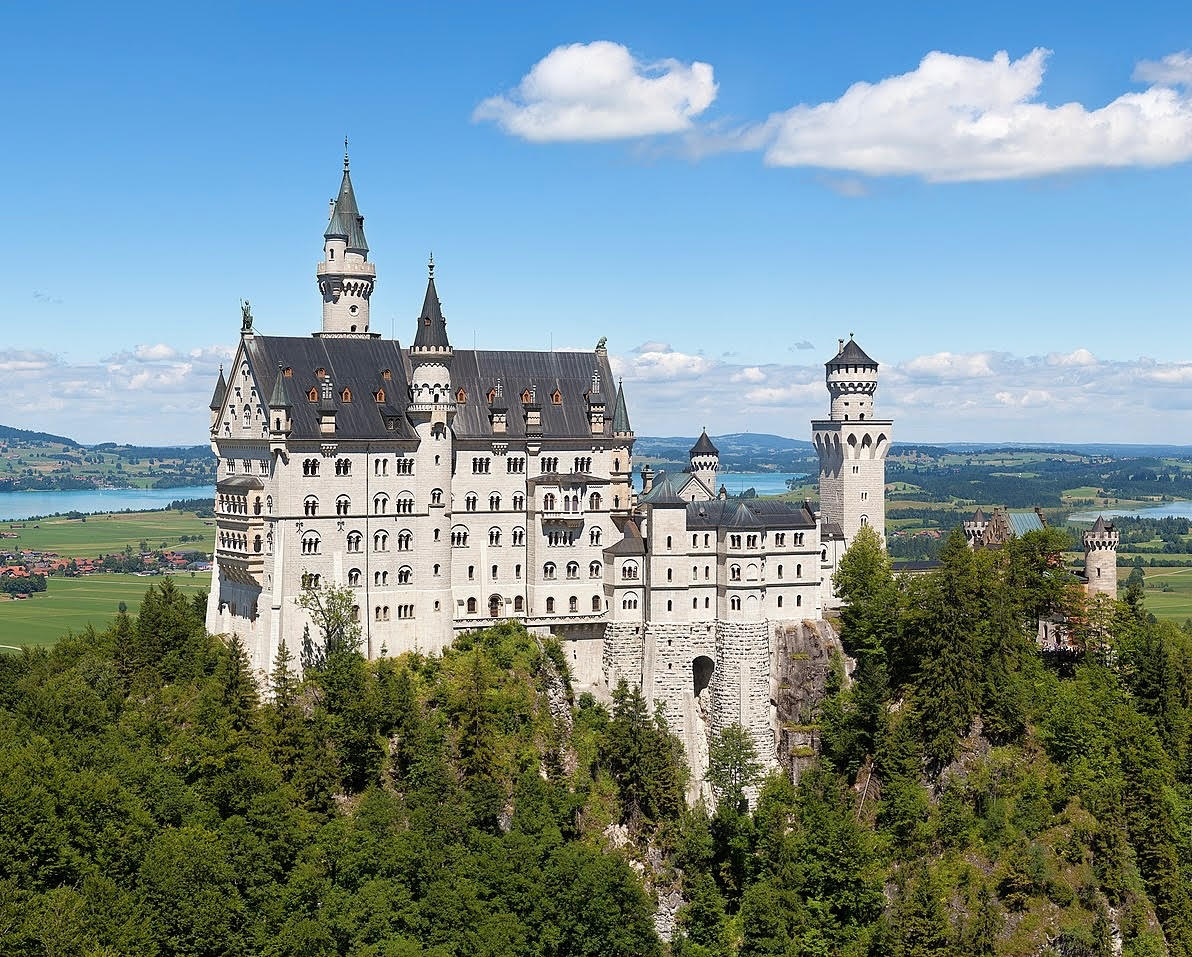
A bit about Schloss Neuschwanstein—it’s the inspiration for Disney’s Sleeping Beauty Castle and has appeared in several anime. It’s filled with a romantic charm, and Disney’s classic castle logo is based on it as well.
I vaguely remember seeing it in my high school social studies textbook as a symbol of Germany. Seeing something in real life that you learned about in school is surreal, though I have no idea what else that textbook chapter was about. Unfortunately, it rained all day, so we missed out on a lot of the views, and our shoes got soaked.
The cell signal here wasn’t great either. I barely had any signal once we started walking toward the castle, so just enjoy the scenery!
It costs money to tour the inside of Schloss Neuschwanstein, but it’s quite expensive, and you need to book in advance. If you’re like me and don’t really appreciate art and historical artifacts, you could skip the interior. There are plenty of spots around the castle that are free to explore, and the exterior views are amazing (although we missed the tour because we didn’t make a reservation).
Marienbrücke

This is the perfect spot to get a panoramic view of Schloss Neuschwanstein. No wonder there’s always a crowd here. Even in the rain, we had to queue up, so I can only imagine how packed it gets on a sunny day.
From the bridge, you get an almost postcard-perfect view of the entire castle. This photo was taken from the bridge, and while it’s misty, the fog adds a sort of dreamy effect, haha.
Schloss Hohenschwangau

Also known as the Old Swan Castle, this yellow castle is located near Neuschwanstein, though not right next to it—you have to walk a bit to reach it. This was where King Ludwig II, the creator of Neuschwanstein, spent his childhood.
It also costs money to enter, so as a poor student, I just wandered around outside. The gift shop and gardens are free to visit though, so you can still experience the grandeur of the castle up close.
Oberammergau

After visiting Neuschwanstein Castle, we decided to stop by this small town nestled at the foot of the Alps. Many people combine a visit to Neuschwanstein with a day trip to Oberammergau. The town is incredibly charming, with beautifully painted houses that make you feel like you’ve stepped into a fairy tale. We were lucky that after dinner, the rain finally stopped, so we could wander around and explore freely.
There aren’t really any specific tourist attractions in the strict sense of the word—you just walk around and find cute things to take photos of. Just be sure to remember where you parked, because it’s easy to get lost and end up somewhere completely different!

The town is full of adorable houses like this, haha.
Summary
Europeans really love their beer, and Germans take it to another level—it feels like they drink beer almost like water! Every meal seems to come with a glass of beer. I figured I should follow the local customs and ordered the cheapest beer with every meal, but I still couldn’t quite appreciate the taste.
Germany does have a tipping culture, but it seems like it’s not a big deal if you don’t follow it. That said, their tipping culture is pretty “in your face.” When paying, the card reader gives you options: 10%, 15%, 20%, or you can enter your own amount, which puts a bit of pressure on you to tip. But sometimes I’m too lazy even to round up to the nearest whole number, so I just click “No, thanks.” Can’t help it, I’m still a poor student, haha.
I’m really glad I had a great group of new friends to travel with this time. It’s funny, though—we met through an exchange program club, but none of them are actually here on an exchange program in Europe, lol. Traveling together was a lot of fun, and I hope we can plan another trip in the future!
Image Source: St. Peter
